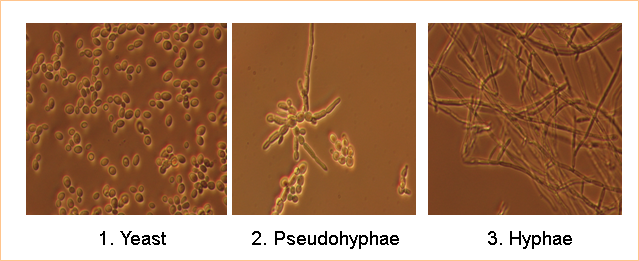BiteSized Immunology: Pathogens & Disease

Candida albicans
Candida albicans is a normal part of the human commensal flora, however it is also the most common fungal species that can cause human disease.
C. albicans causes multiple types of infections but they can be broadly divided into two groups: mucosal and systemic. Mucosal infections present commonly in otherwise healthy women as vulvovaginal candidiasis (thrush), which up to 75% adult women will experience at least once in their life time. C. albicans can also colonise the mouth (oral candidiasis) and can be a problem in newborns and the elderly.
Systemic infection, or disseminated candidiasis, is a much more serious disease. This occurs when a patient is immunosuppressed (due to immunosuppressive drugs, chemotherapy or neutropenia) and C. albicans, normally kept under control by the immune system, invades tissues and enters the bloodstream. C. albicans commonly lives in the human gut therefore invasion of the gut wall by C. albicans (for example, through an ulcer or wound) is thought to one way in which disseminated candidiasis can start. Moreover, C. albicans is able to grow on medical devices, such as intravenous catheters, and this is another way in which patients may become exposed to C. albicans while in the hospital.
C. albicans morphological forms
C. albicans has three distinct morphological forms. It forms:
- a budding yeast,
- pseudohyphae ,and
- filamentous hyphae (Figure 1).
The ability to switch between these forms is controlled by a highly complex genetic network and is dependent on a number of environmental factors. Hyphae are thought to be more virulent since expression of toxins, including the recently discovered Candidalysin, are associated with this morphology. Candidalysin is a toxin secreted by hyphae that damages epithelial cells, and thus may allow C. albicans to penetrate barrier tissues and establish infections.

Immunity to C. albicans
A crucial component in the defence against C. albicans is the pattern recognition receptor, Dectin-1 and its signaling molecule, CARD9. Dectin-1/CARD9 is expressed by innate myeloid cells such as monocytes, dendritic cells and neutrophils. Dectin-1 is required for the efficient phagocytosis and killing of C. albicans, because it binds β-glucans which form a layer within the C. albicans cell wall. CARD9 is needed for Dectin-1 responses, since it transmits the signals to the rest of the cell and is required for production of pro-inflammatory cytokines and activation of important transcription factors. Mice deficient in Dectin-1 or CARD9 are highly susceptible to disseminated candidiasis. In humans, deficiency in CARD9 is a serious immunodeficiency disease that predisposes to disseminated candidiasis. Interestingly, disseminated candidiasis in CARD9-deficient patients only affects the brain and central nervous system. This is because CARD9 is important for recruiting neutrophils to the brain after infection by activating the production of chemokines from neutrophils themselves and resident myeloid cells in the brain.
© The copyright for this work resides with the BSI.
